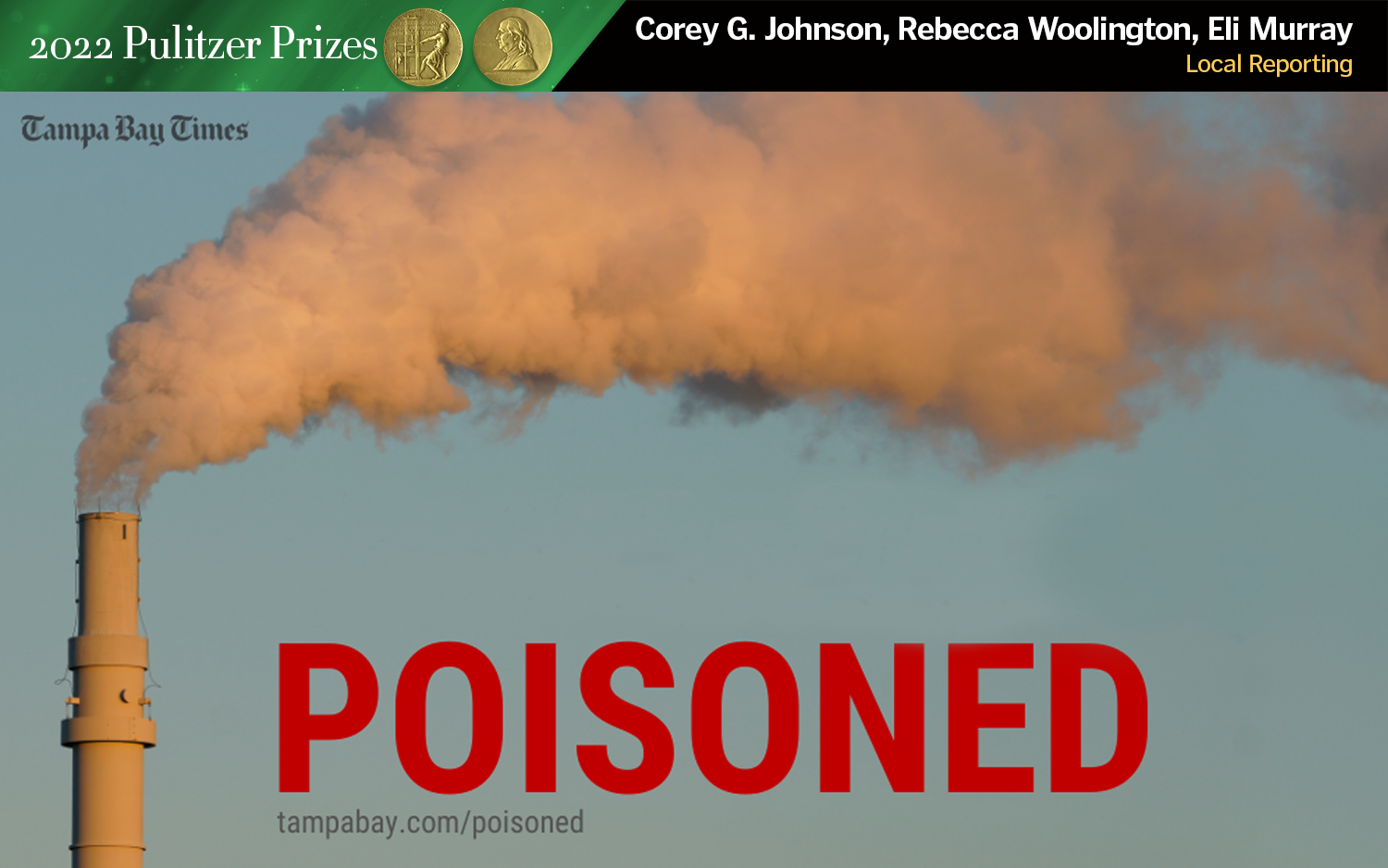The short news lead is dead.
That might be overstated, but I thought I would begin my annual evaluation of Pulitzer Prize leads by writing the shortest lead I could think of — just for effect.
In a day of reading Pulitzer leads, I could not find a short one worthy of attention and appreciation.
But I found a bunch of long leads. Some of the best were long, others were really long, and a couple were incredibly long. One lead was so long that it might not qualify as a lead at all, but as a “lead zone,” the first chapter of a novella.
I can think of reasons for this:
- A number of the winners were for long special projects, created by teams of reporters.
- The results of investigations needed to be summarized at the top, which made leads longer.
- The winners included features from magazines, where introductions and paragraphs tend to be longer.
One of the most memorable Pulitzer leads of the year was written by my young friend John Woodrow Cox of The Washington Post, a “lead-all” for the Post’s coverage of the Jan. 6, 2021, attack on the Capitol. Here are the first four paragraphs, written on deadline:
As President Trump told a sprawling crowd outside the White House that they should never accept defeat, hundreds of his supporters stormed the U.S. Capitol in what amounted to an attempted coup that they hoped would overturn the election he lost. In the chaos, one woman was shot and killed by Capitol Police.
The violent scene — much of it incited by the president’s incendiary language — was like none other in modern American history, bringing to a sudden halt the congressional certification of Joe Biden’s electoral victory.
With poles bearing blue Trump flags, the mob bashed through Capitol doors and windows, forcing their way past police officers unprepared for the onslaught. Lawmakers were evacuated shortly before an armed standoff at the House doors. The woman who was shot by a police officer was rushed to an ambulance, police said, and later died. Canisters of tear gas were fired across the rotunda’s white marble floor, and on the steps outside the building, rioters flew Confederate flags.
“USA!” chanted the would-be saboteurs of a 244-year-old democracy.
That first story would be part of the Post’s coverage that would earn a Pulitzer for Public Service. In the day after it was written, I analyzed that lead in detail, and interviewed the writer, who had previously worked at the Tampa Bay Times.
Speaking of the Tampa Bay Times, I want to honor the lead and the project that just earned my hometown paper its 14th Pulitzer Prize. I have lived in St. Pete for 13 of those prizes. The Times is owned by the school that publishes this website, the Poynter Institute.
Let’s just say we had a dog in the fight. And our dog has a nose for Investigative Reporting.
Published on Sunday, March 28, 2021, the project bears the title “Poisoned,” one of the best titles I can imagine for such a series. The special report was created by Corey G. Johnson, Rebecca Woolington and Eli Murray. They spent 18 months investigating a factory called Gopher Resource. The blurb or intro or lead of their story comprises 88 words, broken up into seven short paragraphs.
Here it is:
Inside Florida’s only lead smelter, poisons abound.
Cadmium. Arsenic. Sulfur dioxide.
But lead is the most prevalent.
Dust laced with lead has hung like a dense fog permeating the factory where workers crack open spent car batteries, extract the lead and melt it down in a furnace that runs at around 1,500 degrees. The molten lead is reforged and sold to companies that make new car batteries and other products.
Hundreds of workers have been exposed to extreme amounts of the neurotoxin.
And the consequences have been profound.
The word “lead,” also spelled “lede,” describes the beginnings of most news stories and other works of nonfiction. It is pronounced LEED. The investigation in question, coincidentally, is about lead poisoning. That heavy metal is pronounced LED.
Here are the reasons I have selected that passage as the Pulitzer Lead of the Year:
Inside Florida’s only lead smelter, poisons abound.
It’s unusual to have the subject and verb of a lead sentence at the end, but it works here. Words at the end of a sentence or paragraph get special attention. “Smelter” is an unusual word that introduces a dangerous work environment. “Abound” feels literary, but not in a showy sort of way. Since the whole project is about lead poisons, it makes sense to get both those words in the first seven.
Cadmium. Arsenic. Sulfur dioxide.
This inventory of poisons works as individual verbless sentences. Each period is a stop sign that slows the reader down in a dramatic way. I have argued that three is the largest number in literature because it is used to represent the whole.
Dust laced with lead has hung like a dense fog permeating the factory where workers crack open spent car batteries, extract the lead and melt it down in a furnace that runs around 1,500 degrees. The molten lead is reforged and sold to companies that make new car batteries and other products.
They say that one job of literature is to make the familiar look strange. In journalism and other forms of public writing, it is to make the strange familiar, to reveal the dangerous hidden realities of the world. That simile of dust and fog, rare in investigative work, denotes a toxic setting, an image reinforced by photography. Verbs do the job here: laced, hung, crack open, extract, melt, reforged. That number 1,500 degrees, burns brightly at the end of the sentence where readers can’t miss it.
Hundreds of workers have been exposed to extreme amounts of the neurotoxin.
The human element is introduced at just the right moment. While writers prefer active verbs, the passive – have been exposed – is the right choice when the subject is the victim of the action.
And the consequences have been profound.
With the exception of those verbless sentences, this final sentence, at six words, is the shortest in the passage. Writers often express their most important point in the shortest sentence. A good lead does not have to tell us everything at the top. It can serve, in the words of author John McPhee, as a flashlight that shines down into the story, inviting and enticing us to experience what is to come.
Call it home cooking if you like, readers, but that represents my best lead of the Pulitzer season.
First runner-up goes to another great Florida paper, the Miami Herald, for this riveting story of a collapsing condo. It was written by Sarah Blaskey, who makes us hear, see and think:
It began with a loud boom, boom.
Then, a thunderous throoom, punctuated by the crash of concrete. Champlain Towers South creaked and groaned but held.
Minutes passed. Four. Five. Six. Seven. Suddenly a tremendous roar fractured the eerie stillness, like an impossibly loud explosion, as the 12-story concrete structure seemed to melt downward from the middle, almost like sand flowing through an hourglass at high speed.
It was unprecedented and seemingly unexplainable — at least at first.
The Herald won the prize for Breaking News Reporting.
Honorable mention goes to Natalie Wolchover, astrophysicist and brilliant editor for Quanta Magazine. The prize for Explanatory Journalism went to a story on the creation of an amazingly powerful new telescope. After I read this first long paragraph, I expected to see a starship from a space movie come cruising by:
To look back in time at the cosmos’s infancy and witness the first stars flicker on, you must first grind a mirror as big as a house. Its surface must be so smooth that, if the mirror were the scale of a continent, it would feature no hill or valley greater than ankle height. Only a mirror so huge and smooth can collect and focus the faint light coming from the farthest galaxies in the sky — light that left its source long ago and therefore shows the galaxies as they appeared in the ancient past, when the universe was young. The very faintest, farthest galaxies we would see still in the process of being born, when mysterious forces conspired in the dark and the first crops of stars started to shine.
There is much more great writing among the Pulitzer winners and finalists. I am sure I have missed some pieces that deserve appreciation and analysis. Cheers to these journalists and to all who labor in the public interest.
And please, readers, if you see a great short lead, send it my way.







